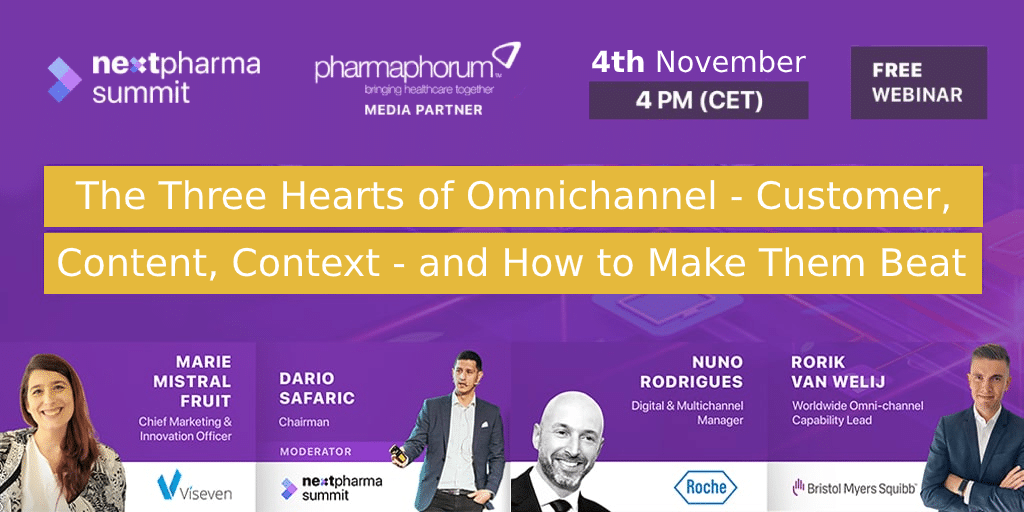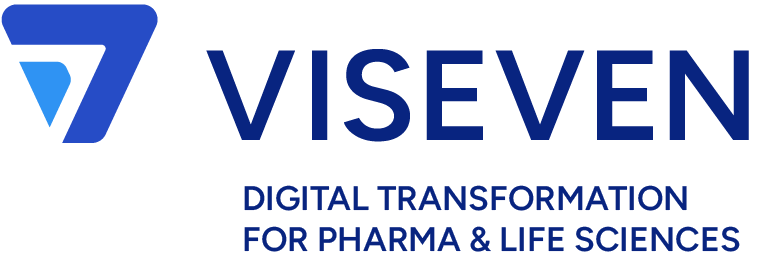Viseven webinar at NEXT Pharma Summit: The Three Hearts of Omnichannel

Ever so many topics to discuss when it comes to digital transformation and innovation in pharma – and just one factor that makes for an excellent discussion platform: is being to the point. NEXT Pharma Summit is an ambitious endeavor intended to satisfy exactly that criterion, becoming, as the organizer’s ambition spells out, the sharpest commercial event for pharma. Successfully so, as we at Viseven may attest, along with numerous partners and sponsors from the industry.
By now, NEXT Pharma Summit is an excellent provider of relevant content on a number of issues in and around pharmaceutical commercial operations, digital excellence, innovation, patient centricity, omnichannel evolution and communications. The hallmark of the project is being extremely selective about the topics to have discussed – and the informational value to provide. No formalism or buzzword abuse, just valuable insights from pharma masterminds, with a bit of insider understanding and loads of materials like webinars, whitepapers and on-demand sessions.
Omnichannel is a burning topic, and also the focus of a recent session featuring Nuno Rodrigues, Digital & Multichannel Manager at Roche, Rorik van Velij, Worldwide Omni-channel Capability Lead at Bristol Myers Squibb, Marie Mistral Fruit, Chief Marketing & Innovation Officer at Viseven, and Dario Safaric, Chairman at NEXT Pharma Summit. In an intense 1-hour session loaded with insights they discussed the three concepts that deserve to be at the heart of a successful omnichannel strategy: Content, Context and Customer, providing actionable ideas and examples from their rich professional experience. Below is a short synopsis of the webinar, as well as a link to access the video recording.
The brief history of omnichannel in pharma
Following the trends in omnichannel is a bit like watching your favorite Netflix series: of course you can start from whatever episode you want, but to gain a real understanding you would likely want to watch from Season 1. Don’t worry, though: the session started with the quickest recap possible, provided by Marie-Mistral Fruit in a retrospective.
Now that we know so much about the evolution of digital capacities in pharma, how do we evaluate the developments of the previous years, and what was the real impact of reps adopting iPads on F2F visits to the HCPs? At some point, the field force was circulating with visual aids to show to HCPs, collecting insights about the market situation and (occasionally) the doctor’s preferences. The latter many of them used to keep to themselves to ensure their own quotas in the following months. However, now we see the full picture and the importance of that data.
#pharmamarketing works in a circular way: interactions boost #data, #CRM data boost interactions, but how to leverage both? The answer is #content, and one has to use it wisely. Expert take by Marie Mistral Fruit of Viseven at @SummitNext webinar! pic.twitter.com/M9bmdF1oPB
— Viseven Digital Content Factory (@viseven_CLM) November 4, 2020
Eventually, the smartest of the marketers and SFE recognized they would likely need to capture the HCP’s motivations, personas and choices in bulk if only to adapt the messaging and craft the content that was worth it. That was when interactive elements made their way into the eDetailing presentations of the “digitalized F2F” engagement era – quick surveys where HCPs would literally manipulate the reps’ tablets to enter information. Those insights, landing in CRM, broke the dam for the entire pharmaceutical communication strategy.
Science first, product-related messaging next – this was the idea that resulted when there was enough data in the pharma marketers’ pockets. When bringing informational value to the HCPs became a recognized necessity, the quality of interactions improved somewhat for those who turned this idea into action. Hence the rise of portals and unbranded campaigns.
The next step? A 360-degree view of the customer, no more and no less, and is what would make omnichannel possible in the first place. Here is another caveat, though: data is harvested from interactions, and to have more quality interactions, you need more data. How to handle this circular logic to spiral outward and scale-up?
The 3 C’s of a successful communication strategy
The problem described above only exists for the model that is currently the norm in most organizations: the “plain multichannel” organization, where the channels are not connected, the HCP gets bombarded by essentially the same messages in each of them, and the learning in each of them never transcend the boundaries of each of them.
Here is where the “three C’s” can be identified to help: Customer, Content, Context. By understanding them properly and aligning them with one another, you can start by creating content for specific cohorts of HCPs but bear in mind the ultimate goal: bringing value and understanding the context and the customer at the level that is currently available to you. This further empowers us to capture even more insights and evolve into a more mature model.
Customer: the starting and ending point of the strategy, since it is their preferences that define the content that is to be delivered. The understanding of the customer is not to be artificially fitted into a formalized pattern, though, as the context of each interaction matters immensely (see below).
Content: still the King, being the vehicle and principal means of communication. Now that we are likely to see less face-to-face interaction in the future, the importance of creating content that does not have to be forced on the audience is rising. This means personalization and careful listening to the needs of the audience… or rather, each individual within that audience.
Context: the where, how and when of each interaction. What has the doctor been exposed to before the touchpoint? Where exactly in the journey are they? How exactly was the message wrapped up and presented to them? What may the doctor have been thinking when the touchpoint occurred?
Calls to action
About 2/3 of the session – everything after the starting presentation – was dedicated to an interactive Q/A blitz, consisting of sharp glimpses of practical, actionable ideas to help get omnichannel on track. Of these, let’s grab just a couple of the more intriguing ones for your consideration.
Contextualize!
As mentioned above, context can be successfully handled in a very narrow, practical sense: the where, how and when. Why does this matter so much? In terms of data, this is one of the reasons that insights from reps are still often superior to the automatically captured KPIs. In the words of Nuno Rodrigues,
I can imagine a physician just stop in the screen about the safety of the product because he’s answering a phone call, and the eDetailing is there for five minutes. So in terms of reporting – “OMG, the doctor is worried about the adverse event!”
On the one hand, this means that at the start, when the omnichannel system is only maturing, one has to listen to the people who know the customer best – the field force, possibly empowering them to orchestrate the experience. On the other hand, the implication concerns the content: it’s not about pushing the message, one has to interact and listen, so the content is flexible enough to fit into any context conceivable. This is what omnichannel offers as compared with multichannel – the messages do not overlap, neither are they forced. Hence the need for an architecture that closes the loop – and smarter content production approaches.
Humanize!
Since pharma no longer needs to create the biggest amount of content, or even the most animated and complex content, the trick is really in being simple and reaching exactly the pinpointed needs of the HCP. This means listening to each of them, but who will be doing that?
The need to free up the people within the organization and enable them to concentrate on the customer is evident when you consider the complexity of the currently existing digital systems in place. In this respect, one can think of the corporate users as “the internal customer” – the one who uses the CRM, marketing automation system, DAM and CMS system, whatever other tools are used in MLR and IT. There have long been calls for a smoother way to validate content, but the point is more integral: kill the complexity in the processes to free the space for yet another big C – Culture.
Rorik van Welij @rikjr of Bristol Myers Squibb @bmsnews on #digitaltransformation in #pharmamktg: it’s really about culture – how to make sure we have the right mindset, and why we are moving from our existing flows into something different. Webinar: pic.twitter.com/Aqqn7dytZ5
— Viseven Digital Content Factory (@viseven_CLM) November 4, 2020
By adopting more agile practices dealing with the hybrid digital/in-the-field paradigm, pharma organizations can leverage the necessary experience to fuse together what tech and human to human interaction can offer – and provide continuous experiences to the HCPs.
Get the full webinar recording
These are just several spoilers of what points the discussion touched, and the presenters used the friendly yet professional atmosphere of an insider dialogue to deliver much more. The good thing is that virtual events are now captured in recording by default – and that is the case with this webinar. You can easily access the full video recording for free below and find more insights on the topic.



